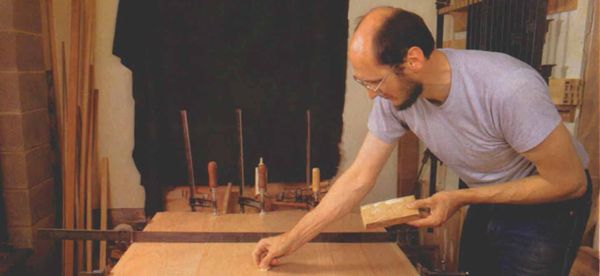
Synopsis: Christian Becksvoort has his rough-sawn lumber milled on two sides to 7/8 in., so that most of the faces will be planed. The result, after handplaning and sanding, is a clean panel that is a full 3/4 in. He offers tips on how to select lumber and how to match grain, color, and growth rings. He trues up the edges first with a jointer or handplane, and he explains how to align boards and avoid introducing twist into your glued-up panels. He shares ideas on clamp tightening and cleaning up the squeeze-out, too.
Many woodworking projects involve gluing together several narrow boards to make a large panel for a tabletop, carcase side or other large surface. The process seems fairly straightforward, but there are many factors to consider. Selecting the stock, matching and orienting the grain, jointing the edges, gluing and clamping ail affect the outcome of the finished panel.
The process begins with proper stock selection. It is highly unlikely that you can get a finished -in.-thick panel out of -in. stock. Even if the glue-up was perfect and the surfaces were planed to perfection, some scraping, sanding or planing would be necessary. Rough lumber is a full inch, which gives ample thickness for machining out a -in.-thick panel. Unfortunately, the surface of roughsawn lumber is so uneven that it is difficult to match grain and color or detect minor imperfections, such as surface checks. Thus, when I purchase stock, I have it milled on two sides to in., hit or miss. This means that most of the faces will be planed (hit), although there will be an occasional patch missed by the planer. To me that’s a good compromise; about 95% to 98% of the surface is visible, yet there is still in. of stock for sanding or planing after the panel is glued. The result is a clean panel that is a full in. thick.
In general, avoid cupped or twisted stock. Bows and crooks are salvageable. The more careful you are in selecting stock, the easier the glue-up and the flatter the panel. When possible, cut all the pieces out of a single board to ensure similar grain and color throughout. Remember, it is virtually impossible to get three 4-ft. pieces out of a 12-ft. board. Most boards must be trimmed from 1 in. to 6 in. on each end to remove checked sections. Individual panel pieces should be 1 in. to 2 in. longer than the finished panel to allow for gluing, clamp “sliding” and final trimming. Also, allow ample width for jointing, especially if the pieces are crooked or have rough edges.
From Fine Woodworking #79
For the full article, download the PDF below:
Fine Woodworking Recommended Products

Jorgensen 6 inch Bar Clamp Set, 4 Pack

Estwing Dead-Blow Mallet






















Log in or create an account to post a comment.
Sign up Log in